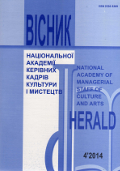ВПЛИВ МИСТЕЦЬКИХ ШКІЛ НА ФОРМУВАННЯ ХУДОЖНЬОГО АВАНГАРДУ В УКРАЇНІ:
10-30–і роки ХХ століття
The art schools' influence on forming the artistic avant-garde in Ukraine in the 1910th-1930th years
Author(s): Olga KarpenkoSubject(s): Visual Arts, Pre-WW I & WW I (1900 -1919)
Published by: Національна академія керівних кадрів культури і мистецтв
Keywords: avant-garde; academism; impressionism; manner; canon; a range of colours; plein air painting; postmodernism; realistic art; socialistic realism; tendency; texture;
Summary/Abstract: Analyzing the avant-garde art, researchers emphasize its revolutionary, dissimilarity with previous trends. The article deals with the analysis of the peculiarities of teaching in Kiev's drawing school of Nicolas Murashko and the methodological analysis of the teaching system in Anthony Azhbe and Shimon Kholloshy's school. These schools had an affect on the worldview and skills of famous Ukrainian and Russian avant-garde artists.The researchers of the avant-garde art O. Fedoruk and V. Markade distinguish two periods of the Ukranian avant-garde. The first wave of avant-garde lasted from 1907 till 1914. During that period the Ukrainian artists adopted artistic achievements of the European masters. The second one lasted from 1917 till 1934. It was characterized by a consciousness and the national identity of Ukrainian avant-garde and the ideological provision on the top of its development.We begin our research from the analysis of the native art schools, which have influenced the education of future pioneers of Ukrainian avant-garde. So touching upon the art situation in Kiev at the beginning of the twentieth century, we have to underline the prominent role of Kiev's drawing school and its founder Nicolas Murashko. After the graduating of the St. Petersburg Art Academy Nicolas Murashko got the idea of founding an art school in Kiev. There was not any higher educational institutions that why many talented artists from Ukraine went to St. Petersburg to receive higher education such as K. Trutovsky, L. Zhemchuzhnikov, A. Slastion, E. Agathon, M. Berkos, M. Fedorov, A. Murashko, S. Vasilkovsky, M. Pimonenko, P. Levchenko, V. Orlovkuy etc. Some Ukrainian artists studied at the Moscow's Painting School, Sculpture and Architecture, such as S. Svyatoslavskyy, F. Krichevsky, M. Zuk, A. Archipenko. The researcher L. Savytska states that at the beginning of the twentieth century only three institutions study the artist. They were the Kiev's art colledge, Lavra icon-painting School and School typography. Kiev Art School followed the traditions of Nicolas Myrashko’s school. There were three main art instituions in Kharkov. They were Raevskaya M. Ivanova’s private drawing school, E. Agafonov’s studio"Blue lily" ("Blue Lily") and A. Groth and E. Steinberg studio.N. Murashko was an extremely thoughtful master and a talented teacher. He closely followed the modern artistic life and analyzed the artistic tendencies in the sociaty. So he critisized the academic system of teaching for its idealism and support the idea of the changable realist art.The important feature of Murashko’ school studing was the development of the artistic imagination by drawing on impressions or memories. Murashko borrowed it from Nikolai Kuznetsov, who was often abroad and brought out such exercise from there. Murashko felt that the system of getting skills had to be changed. The popularity of realistic art, the variability of the effects of light, color and impressionistic discoveries, changed the system of art learning. The cease transformed into the real art. Later, Alexander Bogomazov who had learnt N. Murashko’s technique, called the academism as the pernicious teaching method in his report at the National Congress of Artists in Kiev 1918.A. Ashbe and S. Holloshy’s Munich school played the great role in forming Russian and Ukrainian avant-garde because many native artists improved their professional skills in foreign art schools, studios, academies. Its system of teaching had the innovations, which would be used by many brilliant artists of the twentieth century. Anthony Ashbe taught the representatives of realistic school such as D. Kardovskyy, Russian impressionist I. Grabar and futureabstractionist W. Kandinsky. Such wide variety of artistic trends tells us about his flexible system of teaching and his perfect technique. The researches of A. Ashbe’s school, N. Molyeva and E. Belyutin said that the basis of A. Ashbe’s creative method was the orientation on the transfering the most characteristic features of the model, finding the tools to portray nature without imposing any canons that constrained the artist’s vision. ".So, we can highlight some key points that distinguish N. Murashko, A. Ashbe and S. Holloshy’s schools from the academic system, such as the attention on the study of the living model and the lack of stable canons. The last one saves a student from the copying and helps to find their own way in art. A student has not to draw the reality, but to describe his/her feelings. This new principle, entitled "Art of feeling" (Malevich’s term) is used by the Impressionists and later avant-gardists.
Journal: Вісник Національної академії керівних кадрів культури і мистецтв
- Issue Year: 2014
- Issue No: 4
- Page Range: 134-138
- Page Count: 5
- Language: Ukrainian

